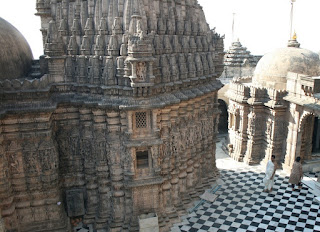 |
| Shatrunjaya hill temples, Gujarat gujarattourism.com |
 |
| Shatrunjaya hill temples, Gujarat gujarattourism.com |
The main pilgrimage site for Jains, in India is not that easily accessible as you would walk into a holy temple in Banares (Varanasi) or in Rameswaram where lakhs of Hindus flock.
The Jains, a primarily a business community, not only live in India but also across the world. The world diamond trade is partly controlled by them and a large community of Jains is living in Antwerp, capital of Belgium engaged in cutting and polishing of raw diamonds, including diamond dust. It is said they have close rapport with orthodox/Hasidic Jews who have been traditional diamond traders in Antwerp for centuries. In 2006 mainly Jain diamond traders accounted for US$19 billion annual diamond trade. Believers of non-violence and strict vegetarians, they have no gods or spiritual figure; they follow certain seers/monks and do believe in reincarnation. They, like Hindus, strive hard to be finally liberated from the the cycle of life and rebirth.
 |
| Shatrunjaya hill temples, Gujarat gujaraticulture.org |
 |
| Climbing the stairs of Shatrunjaya Maha Tirth en.wikipedia.org |
 |
| Shatrunjaya hill temples, Gujarat.agefotostock.com |
hills goes back to the time of Pundarika Swami, a chief Ganadhara and grandson of Rishabha, who attained Nirvana/Moksha here. Located across the main Adinath temple, built by Son of Rishabha, Bharata, lots of pilgrims visit this shrine. Often referred to as Siddhakshetra or Siddhanchal, here many thirtankaras are said to have received enlightenment. It is said that 23 of 24 Jain Tirthankaras, except Neminatha, sanctified the hill by their visits.
 |
| Shatrunjaya hill temples, Gujarat Adisvar temple .jainpedia.org |
Besides, pilgrims also go round the Shatrunjaya hills (in Tamil it is called ''Girivalam'', often associated with Kathigai Deepam at Arunachaleswarar temple, Thiruvannamalai, Tamil Nadu) covering a distance of 216 kilometers (134 mi) on foot, chanting prayers while on the move. Once atop the hill, the devotees wearing white - robe never fail to do their religious duty. It is expected of them to pay homage at each of the complex’s many tuks, similar to temples. As part of worship, barefoot Jains sweep the grounds with brooms and see to it they don’t kill anything before sitting down or sweeping. They engage in chanting of religious texts along with other pilgrims and Jain monks surrounded by Tirthankaras, similar to unclothed Buddha statues.
The Palitana temples, records point out they were built over a period of 900 years starting in the 11th century. It is said that the earliest temples were built by Kumarpal Solanki, a great Jain patron. The builder, it is mentioned, paid the talented sculptors wages, not only according to their skills and capacity to carve with abrasive cords (not tools) the intricate designs, but also on the basis of the marble dust that they had collected every evening after their toil.
 |
| Shatrunjaya hill temples, Gujarat .pinterest.com |
Unfortunately these amazing sculptures and temples were destroyed by the Delhi Sultanate army in 1311 AD. Two years later, the temples saw the rebuilding. However, temple building activities peaked in 1593 when Hiravijayasuri (Chief of Tapa Gaccha) organized a major pilgrimage to this location to attend the consecration ceremony of the temple built for Rishabha by Tej Pal Soni, a merchant. Later lots of temples came up. Invariably most of the present temples date back to the 16th century. In 1656, Shah Jahan’s son Murad Baksh (the then Governor of Gujarat) granted Palitana villages to the prominent Jain merchant Shantidas Jhaveri, a Svetambara Jain. Further, all taxes were also exempted, During the Mogul period, this temple town prospered.
Along with Shikharji in the state of Jharkhand, the two sites are considered the holiest of all pilgrimage places by the Jain community. They strongly believe that a visit to this group of temples is a must to get nirvana or salvation. During the yatra, food must neither be eaten nor carried on the way. Equally important is the descent which should begin before evening. No person shall be allowed to stay for the night atop the sacred hill. The Shatrunjaya hills are considered by many Jains to be more important than the temple-covered hills of Jharkhand, Mount Abu and Girnar.
Etymologically, Shatrunjaya means a “place of victory against inner enemies” or “which conquers inner enemies”. It is to be noted that there are 108 names of Shatrunjaya but only some of them are in common use. The Mahavir Jayanti, the birthday of Mahavira, is an important festival which is celebrated with religious fervor in the temple complex. Every year more than 400000 devotees visit the hill temples at Palitana.
ll









.jfif)